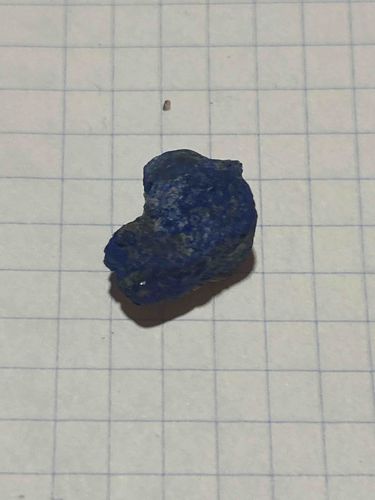
Rough Lapis Lazuli Specimen
This item is a small, irregularly shaped rough specimen of what appears to be Lapis Lazuli, characterized by its striking deep blue color. The specimen exhibits a crystalline or granular texture, typical of metamorphosed rocks. Its surface is rough and unpolished, showing natural fractures and indentations. The color distribution is somewhat uneven, with darker, more intense blue areas interspersed with lighter shades and possibly some grayish inclusions, which could be calcite or other host rock minerals often found with lapis lazuli. The size of the specimen is relatively small, judging by its appearance on grid paper, likely measuring only a few millimeters or a centimeter at its widest point. There are no visible markings, signatures, or manufacturing details, as it is a natural, unprocessed mineral sample. Its condition appears natural for a rough stone, with no apparent wear or damage beyond inherent geological formation characteristics. The presence of a small, lighter-colored particle nearby on the grid paper is likely incidental debris and not part of the specimen itself. The quality indicators point to a natural, unfaceted mineral, potentially suitable for lapidary work, educational display, or as a small collector's piece. The deep blue hue is a desirable characteristic for lapis lazuli. The estimated age is geological.
AI-Generated Appraisal Disclaimer
Estimated Value
$5-15
Basic Information
Category
Mineral Specimen
Appraised On
November 28, 2025
Estimated Value
$5-15
Additional Details Provided By Owner
User Provided Information
Gem
Item Description
This item is a small, irregularly shaped rough specimen of what appears to be Lapis Lazuli, characterized by its striking deep blue color. The specimen exhibits a crystalline or granular texture, typical of metamorphosed rocks. Its surface is rough and unpolished, showing natural fractures and indentations. The color distribution is somewhat uneven, with darker, more intense blue areas interspersed with lighter shades and possibly some grayish inclusions, which could be calcite or other host rock minerals often found with lapis lazuli. The size of the specimen is relatively small, judging by its appearance on grid paper, likely measuring only a few millimeters or a centimeter at its widest point. There are no visible markings, signatures, or manufacturing details, as it is a natural, unprocessed mineral sample. Its condition appears natural for a rough stone, with no apparent wear or damage beyond inherent geological formation characteristics. The presence of a small, lighter-colored particle nearby on the grid paper is likely incidental debris and not part of the specimen itself. The quality indicators point to a natural, unfaceted mineral, potentially suitable for lapidary work, educational display, or as a small collector's piece. The deep blue hue is a desirable characteristic for lapis lazuli. The estimated age is geological.
Related Tags
Get Your Items Appraised
Instant estimates of your treasures with AI-powered instant appraisals